非谓语动词用法区别
(高考非谓语动词用法总结)
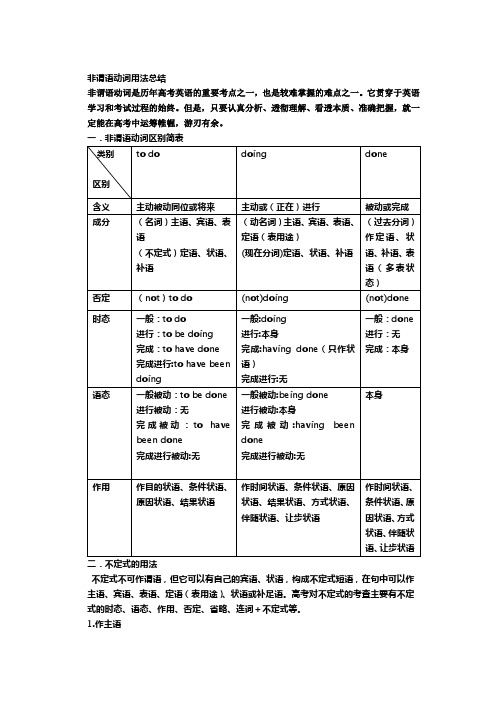
非谓语动词用法总结非谓语动词是历年高考英语的重要考点之一,也是较难掌握的难点之一。
它贯穿于英语学习和考试过程的始终。
但是,只要认真分析、透彻理解、看透本质、准确把握,就一定能在高考中运筹帷幄,游刃有余。
一.非谓语动词区别简表二.不定式的用法不定式不可作谓语,但它可以有自己的宾语、状语,构成不定式短语,在句中可以作主语、宾语、表语、定语(表用途)、状语或补足语。
高考对不定式的考查主要有不定式的时态、语态、作用、否定、省略、连词+不定式等。
1.作主语不定式作主语表示具体的动作,通常指一件已知的事或目的。
不定式作主语时,谓语动词用单数。
eg:To say is a thing,to do is another.(说是一回事,做是另外一回事。
)(2)不定式短语较长时,通常放在谓语之后,用it作形式主语。
eg:①It is important to learn English well.(学好英语是重要的。
)②It is necessary for us to do the job well.(我们做好这项工作是必要的。
)③It is a great honor to be invited to give a speech here.(被邀请在这儿发表演讲是一个极大的荣幸。
)2.作宾语(1)常只用不定式作宾语的动词有:want,wish,hope,long,expect,desire,intend,decide,ask,promise,aim,offer,agree,plan,l earn,choose,refuse,fail,manage,pretend等。
eg:①He refused to help me.(他拒绝帮助我.)②She has agreed to come tomorrow.(他已同意明天来.)(2) 不定式较长时,作宾语,也可用it代替,放在后面。
eg;I find it difficult to do the job well.(3) “特殊疑问词﹢不定式to do结构”具有名词特征,可作宾语。
(高考非谓语动词用法总结)
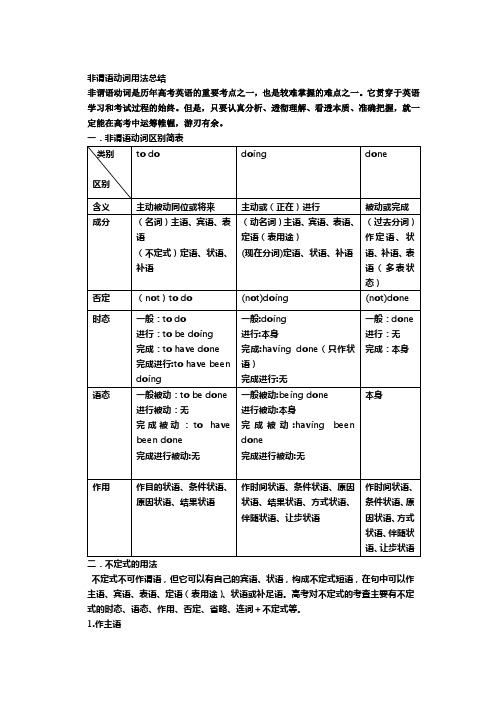
非谓语动词用法总结非谓语动词是历年高考英语的重要考点之一,也是较难掌握的难点之一。
它贯穿于英语学习和考试过程的始终。
但是,只要认真分析、透彻理解、看透本质、准确把握,就一定能在高考中运筹帷幄,游刃有余。
不定式不可作谓语,但它可以有自己的宾语、状语,构成不定式短语,在句中可以作主语、宾语、表语、定语(表用途)、状语或补足语。
高考对不定式的考查主要有不定式的时态、语态、作用、否定、省略、连词+不定式等。
1.作主语不定式作主语表示具体的动作,通常指一件已知的事或目的。
不定式作主语时,谓语动词用单数。
eg:To say is a thing,to do is another.(说是一回事,做是另外一回事。
) (2)不定式短语较长时,通常放在谓语之后,用it作形式主语。
eg:①It is important to learn English well.(学好英语是重要的。
)②It is necessary for us to do the job well.(我们做好这项工作是必要的。
)③It is a great honor to be invited to give a speech here.(被邀请在这儿发表演讲是一个极大的荣幸。
)2.作宾语(1)常只用不定式作宾语的动词有:want,wish,hope,long,expect,desire,intend,decide,ask,promise,aim,offer,ag ree,plan,learn,choose,refuse,fail,manage,pretend等。
eg:①He refused to help me.(他拒绝帮助我.)②She has agreed to come tomorrow.(他已同意明天来.)(2) 不定式较长时,作宾语,也可用it代替,放在后面。
eg;I find it difficult to do the job well.(3) “特殊疑问词﹢不定式to do结构”具有名词特征,可作宾语。
非谓语动词用法总结

非谓语动词用法总结非谓语动词是历年高考英语的重要考点之一,同时也是较难掌握的难点之一。
它贯穿于英语学习和考试过程的始终。
但是,只要认真分析、透彻理解、看透本质、准确把握,就一定能在高考中运筹帷幄,游刃有余。
一.非谓语动词区别简表二.不定式的用法不定式不可作谓语,但它可以有自己的宾语、状语,构成不定式短语,在句中可以作主语、宾语、表语、定语(表用途)、状语或补足语。
高考对不定式的考查主要有不定式的时态、语态、作用、否定、省略、连词+不定式等。
作主语不定式作主语表示具体的动作,通常指一件已知的事或目的。
不定式作主语时,谓语动词用单数。
eg:To say is a thing,to do is another.(说是一回事,做是另外一回事。
)(2)不定式短语较长时,通常放在谓语之后,用it作形式主语。
eg:①It is important to learn English well.(学好英语是重要的。
)②It is necessary for us to do the job well.(我们做好这项工作是必要的。
)③It is a great honor to be invited to give a speech here.(被邀请在这儿发表演讲是一个极大的荣幸。
)2.作宾语(1)常只用不定式作宾语的动词有:want,wish,hope,long,expect,desire,intend,decid e,ask,promise,aim,offer,agree,plan,learn,choos e,refuse,fail,manage,pretend等。
eg:①He refused to help me.(他拒绝帮助我.)②She has agreed to come tomorrow.(他已同意明天来.)(2) 不定式较长时,作宾语,也可用it代替,放在后面。
eg;I find it difficult to do the job well.(3) “特殊疑问词﹢不定式to do结构”具有名词特征,可作宾语。
英语非谓语动词用法区别

英语非谓语动词用法区别
非谓语动词是指在句子中充当非谓语成分的动词形式,分为不定式、动名词和分词。
在英语中,非谓语动词的使用具有一定的区别,这些区别主要体现在以下几个方面:
1. 用作主语时:动名词和不定式可以作主语,而分词则不能作主语。
2. 修饰名词时:动名词和分词可以作形容词或副词修饰名词,而不定式则不能。
3. 表示时间关系时:不定式表示将来的时间关系,动名词表示正在进行的动作,分词表示完成的动作。
4. 用作目的状语时:不定式和动名词可以用作目的状语,而分词则不能。
5. 用作结果状语时:只有分词可以用作结果状语,表示一个已完成的动作所带来的结果。
总之,非谓语动词在英语中的使用需要根据不同的语境和需要进行区分和选择,正确运用非谓语动词可以使句子更加简洁明了,表达更加准确清晰。
- 1 -。
英语非谓语动词的用法及比较
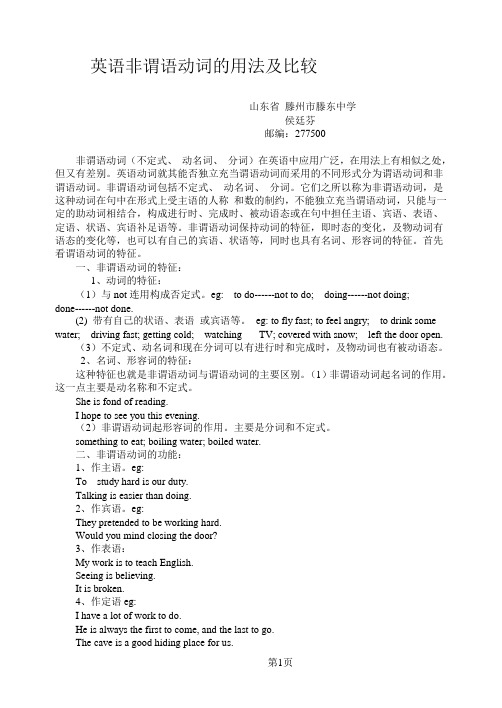
英语非谓语动词的用法及比较山东省滕州市滕东中学侯廷芬邮编:277500非谓语动词(不定式、动名词、分词)在英语中应用广泛,在用法上有相似之处,但又有差别。
英语动词就其能否独立充当谓语动词而采用的不同形式分为谓语动词和非谓语动词。
非谓语动词包括不定式、动名词、分词。
它们之所以称为非谓语动词,是这种动词在句中在形式上受主语的人称和数的制约,不能独立充当谓语动词,只能与一定的助动词相结合,构成进行时、完成时、被动语态或在句中担任主语、宾语、表语、定语、状语、宾语补足语等。
非谓语动词保持动词的特征,即时态的变化,及物动词有语态的变化等,也可以有自己的宾语、状语等,同时也具有名词、形容词的特征。
首先看谓语动词的特征。
一、非谓语动词的特征:1、动词的特征:(1)与not连用构成否定式。
eg: to do------not to do; doing------not doing;done------not done.(2) 带有自己的状语、表语或宾语等。
eg: to fly fast; to feel angry; to drink some water; driving fast; getting cold; watching TV; covered with snow; left the door open.(3)不定式、动名词和现在分词可以有进行时和完成时,及物动词也有被动语态。
2、名词、形容词的特征:这种特征也就是非谓语动词与谓语动词的主要区别。
(1)非谓语动词起名词的作用。
这一点主要是动名称和不定式。
She is fond of reading.I hope to see you this evening.(2)非谓语动词起形容词的作用。
主要是分词和不定式。
something to eat; boiling water; boiled water.二、非谓语动词的功能:1、作主语。
eg:To study hard is our duty.Talking is easier than doing.2、作宾语。
非谓语动词的用法
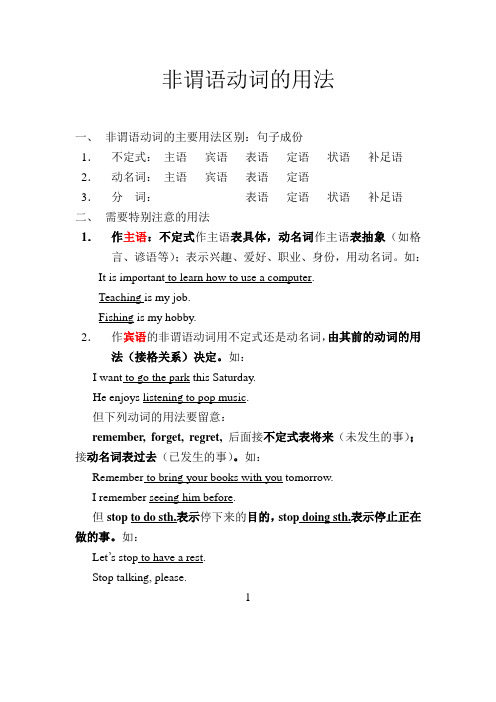
非谓语动词的用法一、非谓语动词的主要用法区别:句子成份1.不定式:主语宾语表语定语状语补足语2.动名词:主语宾语表语定语3.分词:表语定语状语补足语二、需要特别注意的用法1.作主语:不定式作主语表具体,动名词作主语表抽象(如格言、谚语等);表示兴趣、爱好、职业、身份,用动名词。
如:It is important to learn how to use a computer.Teaching is my job.Fishing is my hobby.2.作宾语的非谓语动词用不定式还是动名词,由其前的动词的用法(接格关系)决定。
如:I want to go the park this Saturday.He enjoys listening to pop music.但下列动词的用法要留意:remember, forget, regret,后面接不定式表将来(未发生的事);接动名词表过去(已发生的事)。
如:Remember to bring your books with you tomorrow.I remember seeing him before.但stop to do sth.表示停下来的目的,stop doing sth.表示停止正在做的事。
如:Let’s stop to have a rest.Stop talking, please.13.作表语:不定式作表语通常表将来,动名词作表语通常表兴趣、爱好、职业、身份(可与主语换位),分词作表语表特征或者属性(怎么样)。
如:Our task tomorrow is to study Lesson 5.My job is teaching.The story is very interesting.4.作定语:不定式作定语通常表将来(未发生),作宾语的定语时主动表被动;动名词作定语表作用或者用途;分词作定语表特征或者属性。
如:I have something to tell you.He has no pen to write with.When she writes, she usually uses writing paper.writing pen(书法笔), meeting room(会议室), dining room(餐厅), etc.That movie is very moving.The football match was very exciting.5.作状语:不定式作状语一般表目的,分词作状语不表目的。
非谓语动词的用法比较

非谓语动词的用法比较(一)非谓语动词句法功能一览表总体上来讲,动名词表示一般的、习惯性或规律性的动作;而不定式则表示具体的、单一的、特定情况下的动作。
动名词表示以前的或已完成的动作;而不定式表示将做、未做之动作。
(三)用法比较⒈作主语Teaching English is my job.To teach her English is my job.它们的短语作主语时,都可以用it作形式主语。
It's not easy to learn English well.It's no use discussing the matter now.但动名词作主语时,有其特定的句型。
⑴It's no use+v-ing⑵It's no good+v-ing⑶There's no+v-ing⑷No+v-ing⒉作宾语英语里大多数动词既可以接动名词作宾语,又可以接不定式作宾语,且意义差别不大。
但是:⑴下列动词只能接不定式作宾语:afford, agree, ask, expect, fail, hesitate, hope, learn, offer, plan, pretend, promise, refuse, want, wish等⑵下列词(组)只能接动名词作宾语:① admit, advise, allow, appreciate, avoid, consider(考虑), delay, enjoy, escape, excuse, fancy, finish, imagine, keep, mind, miss, pardon, permit, practise, risk, report, require, suggest(建议), understand等;② can't help /bear / stand(忍不住), feel like, give up, insist on, keep on, put off, set about等;③ be busy, be worth等;④ be/get/become used to, object to, come to (谈到)devote oneself to, get down to, lead to, look forward to, pay attention to, stick to等。
非谓语动词用法对比

非谓语动词用法对比英语中动词分为两大类:一类是谓语动词,一类是非谓语动词.顾名思义,谓语动词就是在句子中做谓语的动词,即do;而非谓语动词在句子中可以做除了谓语以外的其他任何成分,即doing\to do\done.在句子中充当除谓语以外的各种句子成分的动词形式叫做非谓语动词.非谓语动词有三种:不定式、动名词和分词(现在分词和过去分词).知识要点:一、不定式与动名词做主语:1) 不定式一般表示具体的、特定的行为;而-ing分词一般表示抽象的、一般的行为。
动名词作主语时,它已经将动词名词化了,已把某个动作视为某种活动或事情了,动作意义很弱,比较抽象;而不定式作主语,动作意义强,多指“要去做某事”,这种动作往往是“要发生的一次性动作”,比较具体。
如:To complete the program needs much effort. 完成这项计划需要很大的努力。
Riding a bike can make a man smart. 骑单车能使一个人敏捷。
Smoking is forbiden. 抽烟是禁止的。
To smoke here is not very good. 在这抽烟不太好。
(2) 在疑问句中,只能用动名词的复合结构作主语。
如:Is his speaking reasonable? 她的说话有道理吗?(3) 在某些句型中通常要用动名词短语作主语。
如:It is no use doing…It is no good doing…It is useless doing…It is worthwhile doing…如:It is no use talking your trouble to a man like him. 跟他那样的人谈你的烦恼没有用。
常用不定式做主语的句型有:It’s difficult (important, necessary…) for sb. to do…It’s kind (good, friendly, polite, careless, rude, cruel, clever, foolish, brave…) of sb.to do…(4) 一般说来,作主语和表语的非谓语动词形式应一致,即:或同时为不定式,或同时为-ing 分词。
非谓语动词用法总结

非谓语动词用法总结非谓语动词作主语一.动词不定式作主语1.不定式作主语表示具体的动作,通常指一件已知的事或目的。
不定式作主语时,谓语动词用单数。
To say is a thing,to do is another.(说是一回事,做是另外一回事。
)2. 不定式短语较长时,通常放在谓语之后,用it作形式主语。
①It is important to learn English well.(学好英语是重要的。
)②It is necessary for us to do the job well.(我们做好这项工作是必要的。
)③It is a great honor to be invited to give a speech here.(被邀请在这儿发表演讲是一个极大的荣幸。
)二.动词ing不定式作主语1.动名词做主语往往表示经常性、习惯性的动作或状态。
Watching news on TV has become a routine for me.(经常性、习惯性的动作)Talking is easier than doing.(状态)(1)动名词直接置于句首。
Talking is easier than doing.(2).Ving 形式作主语时常后置,用it作形式主语Playing video games is a waste of timeIt is a waste of time playing video games常见句式:It is no good/no use/ useless doing sth 做...没有用的It is a waste of time doing sth做...是浪费时间的(3).There be 结构中作主语:A. There is no+doing 表示不可能做某事There is no knowing the future ==we can’t know the future. 我们不可能知道未来发生什么B.There is no point doing 做某事没有意义There’s no point having wishes if you don’t at least try t o do them.拓展:动名词作主语时,单个V-ing 做主语,谓语动词用单数。
如何区分三种非谓语动词
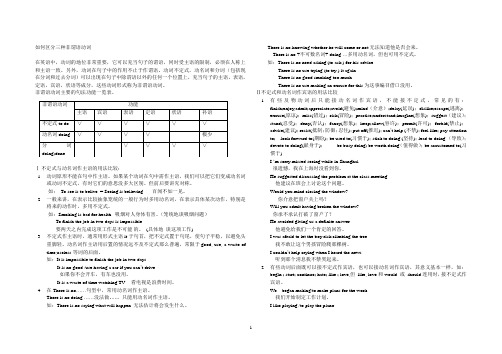
如何区分三种非谓语动词在英语中,动词的地位非常重要,它可以充当句子的谓语,同时受主语的限制,必须在人称上和主语一致。
另外,动词在句子中的作用不止于作谓语。
动词不定式,动名词和分词(包括现在分词和过去分词)可以出现在句子中除谓语以外的任何一个位置上,充当句子的主语,表语,定语,宾语,状语等成分,这些动词形式称为非谓语动词。
非谓语动词主要的句法功能一览表。
Ⅰ.不定式与动名词作主语的用法比较:1.动词原形不能在句中作主语。
如果某个动词在句中需作主语,我们可以把它们变成动名词或动词不定式,有时它们的意思没多大区别。
但前后要讲究对称。
如:To see is to belive. = Seeing is believing. 百闻不如一见。
2.一般来讲,在表示比较抽象笼统的一般行为时多用动名词,在表示具体某次动作,特别是将来的动作时,多用不定式。
如:Smoking is bad for health. 吸烟对人身体有害。
(笼统地谈吸烟问题)To finish the job in two days is impossible.要两天之内完成这项工作是不可能.的。
(具体地谈这项工作)3.不定式作主语时,通常用形式主语it于句首,把不定式置于句尾,使句子平稳,以避免头重脚轻。
动名词作主语用后置的情况远不及不定式那么普遍,常限于good, use, a waste of time,useless等词的后面。
如:It is impossible to finish the job in two days.It is no good /use having a car if you can’t drive.如果你不会开车,有车也没用。
It is a waste of time watching TV. 看电视是浪费时间。
4.在There is no……句型中,常用动名词作主语。
There is no doing ……没法做。
非谓语动词用法总结

非谓语动词用法总结非谓语动词是历年高考英语的重要考点之一,同时也是较难掌握的难点之一。
它贯穿于英语学习和考试过程的始终。
但是,只要认真分析、透彻理解、看透本质、准确把握,就一定能在高考中运筹帷幄,游刃有余。
一.非谓语动词区别简表二.不定式的用法不定式不可作谓语,但它可以有自己的宾语、状语,构成不定式短语,在句中可以作主语、宾语、表语、定语(表用途)、状语或补足语。
高考对不定式的考查主要有不定式的时态、语态、作用、否定、省略、连词+不定式等。
作主语不定式作主语表示具体的动作,通常指一件已知的事或目的。
不定式作主语时,谓语动词用单数。
eg:To say is a thing,to do is another.(说是一回事,做是另外一回事。
)(2)不定式短语较长时,通常放在谓语之后,用it作形式主语。
eg:①It is important to learn English well.(学好英语是重要的。
)②It is necessary for us to do the job well.(我们做好这项工作是必要的。
)③It is a great honor to be invited to give a speech here.(被邀请在这儿发表演讲是一个极大的荣幸。
)2.作宾语(1)常只用不定式作宾语的动词有:want,wish,hope,long,expect,desire,intend,decid e,ask,promise,aim,offer,agree,plan,learn,choos e,refuse,fail,manage,pretend等。
eg:①He refused to help me.(他拒绝帮助我.)②She has agreed to come tomorrow.(他已同意明天来.)(2) 不定式较长时,作宾语,也可用it代替,放在后面。
eg;I find it difficult to do the job well.(3) “特殊疑问词﹢不定式to do结构”具有名词特征,可作宾语。
(高考非谓语动词用法总结)

(高考非谓语动词用法总结)非谓语动词用法总结非谓语动词是历年高考英语的重要考点之一,也是较难掌握的难点之一。
它贯穿于英语学习和考试过程的始终。
但是,只要认真分析、透彻理解、看透本质、准确把握,就一定能在高考中运筹帷幄,游刃有余。
不定式不可作谓语,但它可以有自己的宾语、状语,构成不定式短语,在句中可以作主语、宾语、表语、定语(表用途)、状语或补足语。
高考对不定式的考查主要有不定式的时态、语态、作用、否定、省略、连词+不定式等。
1.作主语不定式作主语表示具体的动作,通常指一件已知的事或目的。
不定式作主语时,谓语动词用单数。
eg:To say is a thing,to do is another.(说是一回事,做是另外一回事。
) (2)不定式短语较长时,通常放在谓语之后,用it作形式主语。
eg:①It is important to learn English well.(学好英语是重要的。
)②It is necessary for us to do the job well.(我们做好这项工作是必要的。
)③It is a great honor to be invited to give a speech here.(被邀请在这儿发表演讲是一个极大的荣幸。
)2.作宾语(1)常只用不定式作宾语的动词有:want,wish,hope,long,expect,desire,intend,decide,ask,promise,aim,offer,ag ree,plan,learn,choose,refuse,fail,manage,pretend等。
eg:①He refused to help me.(他拒绝帮助我.)②She has agreed to come tomorrow.(他已同意明天来.)(2) 不定式较长时,作宾语,也可用it代替,放在后面。
eg;I find it difficult to do the job well.(3) “特殊疑问词﹢不定式to do结构”具有名词特征,可作宾语。
非谓语三种形式的区别和辨析

非谓语动词三种形式用法的区别:1. 做主语:v-ing & to do 都可以做主语,大多数情况两者没有区别。
注意:但是v-ed不可以做主语。
Exploring the Amazon River deserves courage. ( doing 表抽象的概念)To explore the Amazon River deserves courage. ( to do 表具体的/将来的动作)其余注意事项:1)Seeing is believing.To see is to believe. (即:主语与表语的形式要一致)但是不能说:Seeing is to believe; 或者To see is believing.2)Lincoln said it was not right for the south to break away from the union.Linda said it was nice of you to lend her money.The children’s loving nature can surely inspire their love for their family members.3) It is no good / no use / useless + doing sth 句型It’s no use crying over spilt milk.4) There is no + doing. 句型There is no knowing what will happen next. 谁也不知道下一步会发生什么。
There is no telling what will happen. 谁也无法判断、辨别将要发生什么。
2. 做表语:My favorite hobby is to collect / collecting old coins. (一般概念to do/doing 可以互换)Our aim is to help the old lead a happy life. (表具体的/将来的动作用to do)We were all greatly amazed at the children’s wonderful performance.The children’s wonderful performance was amazing.3. 作宾语:用哪种形式做宾语往往跟动词的搭配用法有关like / love to do & like / love doing;begin / start to do & begin / start doing;prefer to do & prefer doing;continue to do & continue doing;try to do VS try doing;mean to do VS mean doing;can’t help doing VS can’t help (to) dogo on to do VS go on doing;stop to do VS stop doing;forget to do VS forget doing / forget having doneregret to do VS regret doing / regret having done;remember to do VS remember doing / remember having done;sth need doing & sth need to be done (需要)sth require doing & sth require to be done (需要)sth want doing & sth want to be done (需要)sth deserve doing & sth deserve to be done (值得)需要注意的重要形式:特殊疑问词(how / what / when/ where…) + to do = 宾语从句Hearing the sad news, I didn’t know what to do.= Hearing the sad news, I didn’t know what I could do.I couldn’t decide whether to work another year or change my job.= I couldn’t decide whether I could work another year or change my job.2)it 做形式宾语,to do / doing做真正的宾语I though it an honor to have been invited to dinner. ( to be invited to dinner的完成式) I found it no use attempting to lose weight by going on diet.3)I’m looking forward to seeing you again.I have no choice but to stay home for another hour.I have nothing to do but stay home for another hour.I can do nothing but stay home for another hour.4. 作宾语补足语:(考试重点)I often notice a little boy pass this corridor and enter the garden.I found a stranger walking nearby our shop.( doing 强调动作正在进行;(看到、注意到)动作的一部分)( to do强调动作已经完成;(看到、注意到)动作的全过程请注意下列句子的区别:We heard her singing next door. (听到她唱歌动作的一部分;听到她正在唱歌) (主动正在进行)We heard her sing next door. (听到她唱歌动作的全部分;听到她唱过歌) (主动完成)We heard the song sung by her. (听到这首歌被她唱过) (被动完成)We heard the song being sung by her next door. (听到她这首歌正在被她唱)(被动正在进行)Don’t have the water running all the day. (让…一直做) (主动,一直进行)The teacher had him read the text three times. (让...做…)(主动,做具体一件事情)I had my hair colored last Friday. (让…由别人做;遭遇到不好的事情)(被动,有别人完成)注意跟I have a lot of homework to do today. (有) 的区别。
非谓语动词用法归纳
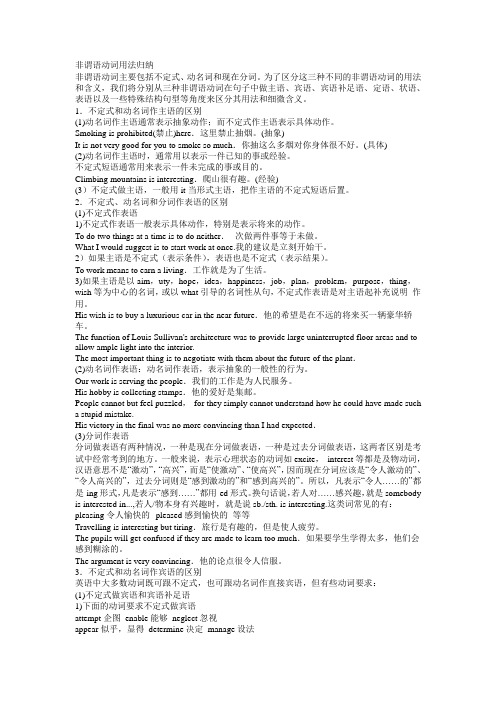
非谓语动词用法归纳非谓语动词主要包括不定式、动名词和现在分词。
为了区分这三种不同的非谓语动词的用法和含义,我们将分别从三种非谓语动词在句子中做主语、宾语、宾语补足语、定语、状语、表语以及一些特殊结构句型等角度来区分其用法和细微含义。
1.不定式和动名词作主语的区别(1)动名词作主语通常表示抽象动作;而不定式作主语表示具体动作。
Smoking is prohibited(禁止)here.这里禁止抽烟。
(抽象)It is not very good for you to smoke so much.你抽这么多烟对你身体很不好。
(具体)(2)动名词作主语时,通常用以表示一件已知的事或经验。
不定式短语通常用来表示一件未完成的事或目的。
Climbing mountains is interesting.爬山很有趣。
(经验)(3)不定式做主语,一般用it当形式主语,把作主语的不定式短语后置。
2.不定式、动名词和分词作表语的区别(1)不定式作表语1)不定式作表语一般表示具体动作,特别是表示将来的动作。
To do two things at a time is to do neither.--次做两件事等于未做。
What I would suggest is to start work at once.我的建议是立刻开始干。
2)如果主语是不定式(表示条件),表语也是不定式(表示结果)。
To work means to earn a living.工作就是为了生活。
3)如果主语是以aim,uty,hope,idea,happiness,job,plan,problem,purpose,thing,wish等为中心的名词,或以what引导的名词性从句,不定式作表语是对主语起补充说明作用。
His wish is to buy a luxurious car in the near future.他的希望是在不远的将来买一辆豪华轿车。
四种非谓语动词都可做表语和定语,如何轻松区分它们的用法?
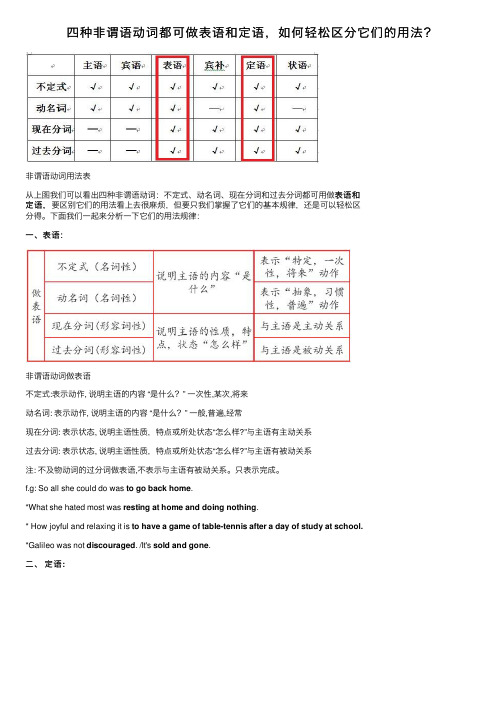
四种⾮谓语动词都可做表语和定语,如何轻松区分它们的⽤法?⾮谓语动词⽤法表表语和从上图我们可以看出四种⾮谓语动词:不定式、动名词、现在分词和过去分词都可⽤做表语和定语,要区别它们的⽤法看上去很⿇烦,但要只我们掌握了它们的基本规律,还是可以轻松区定语,分得。
下⾯我们⼀起来分析⼀下它们的⽤法规律:⼀、表语:⾮谓语动词做表语不定式:表⽰动作, 说明主语的内容 “是什么?” ⼀次性,某次,将来动名词: 表⽰动作, 说明主语的内容 “是什么?” ⼀般,普遍,经常现在分词: 表⽰状态, 说明主语性质,特点或所处状态“怎么样?”与主语有主动关系过去分词: 表⽰状态, 说明主语性质,特点或所处状态“怎么样?”与主语有被动关系注: 不及物动词的过分词做表语,不表⽰与主语有被动关系。
只表⽰完成。
f.g: So all she could do was to go back home.*What she hated most was resting at home and doing nothing.* How joyful and relaxing it is to have a game of table-tennis after a day of study at school.*Galileo was not discouraged. /It's sold and gone.⼆、定语:(1)不定式(后置)a. 与修饰名词主动关系;⽤⼀般主动式(to do),表⽰将来f.g:So he made some candles to give light.b. 与修饰名词被动关系,表⽰将来①与本句中的“主语”是主动关系时,⽤⼀般主动式(to do)f.g:Have you anything to say for yourself?②与本句中的“主语”是不不主动关系时,⽤⼀般被动式:to be donef.g:I’m going to the post office. Have you anything to besent?③不定式为“不及物动词+介词”作定语时,“介词”不可漏掉。
高考英语非谓语动词区别简表及用法详述(共...

非谓语动词区别简表及具体用法详述非谓语动词是历年高考英语的重要考点之一,也是较难掌握的难点之一。
它贯穿于英语学习和考试过程的始终。
但是,只要认真分析、透彻理解、看透本质、准确把握,就一定能在高考中运筹帷幄,游刃有余。
一.非谓语动词区别简表注1:注1:(名词)to do, doing的区别⒈二者都可表示普遍的、一般的的真理、见解或信念等。
eg: To do morning exercises/ Doing morning exercises is good for your health.⒉不定式表示尚未发生的动作;动名词暗示已经存在。
eg: My father is a millionaire, but having money doesn't mean everything.⒊动名词表示一般的经验;不定式表示具体的、特定的事例、意见或理论。
eg:①I prefer swimming to fishing.②I like to swim in the river because it's too hot today.⒋不定式和动名词都有对称性。
eg:①To see is to believe.②Seeing is believing.⒌作主语时to do, doing的区别⑴表示泛指、一般、抽象或一个已经完成了的动作时,强调的是事情本身,多用动名词doing作主语。
⑵表示具体某一次行为,特别是将来的动作时,强调的是动词本身,必须用不定式作主语。
注:表示泛指意义时,多用动名词doing(也可用动词不定式to do)⒍作宾语时to do, doing的区别⑴doing表示泛指,一般,经常性,习惯性的动作。
⑵to do表示特定,具体,将来的动作。
⒎作表语时to do, doing的区别⑴表示一般的概念时,二者可以互换。
⑵表示具体的动作或将来的行为时,应用不定式to do。
⒏不定式to do,现在分词doing作补语时的区别⑴不定式to do作补语表示宾语所做的动作或者和宾语有表语关系,表示状态、特性、身份等。
词法:非谓语动词用法区别
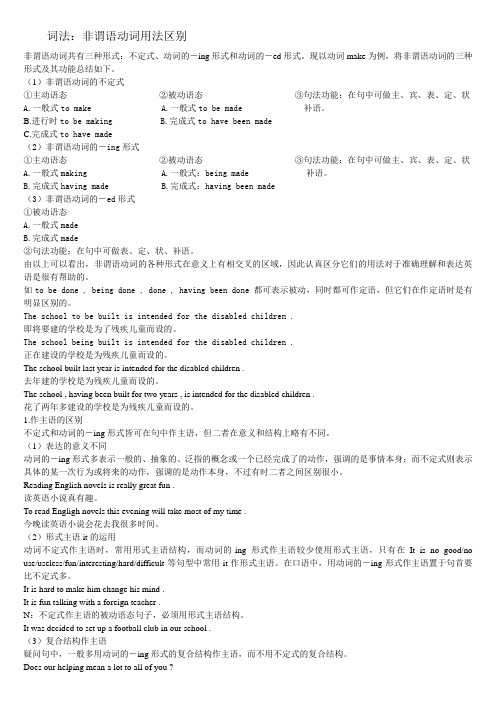
词法:非谓语动词用法区别非谓语动词共有三种形式:不定式、动词的-ing形式和动词的-ed形式。
现以动词make为例,将非谓语动词的三种形式及其功能总结如下。
(1)非谓语动词的不定式①主动语态②被动语态③句法功能:在句中可做主、宾、表、定、状A.一般式to make A.一般式to be made 补语。
B.进行时to be making B.完成式to have been madeC.完成式to have made(2)非谓语动词的-ing形式①主动语态②被动语态③句法功能:在句中可做主、宾、表、定、状A.一般式making A.一般式:being made 补语。
B.完成式having made B.完成式:having been made(3)非谓语动词的-ed形式①被动语态A.一般式madeB.完成式made②句法功能:在句中可做表、定、状、补语。
由以上可以看出,非谓语动词的各种形式在意义上有相交叉的区域,因此认真区分它们的用法对于准确理解和表达英语是很有帮助的。
如to be done , being done , done , having been done 都可表示被动,同时都可作定语,但它们在作定语时是有明显区别的。
The school to be built is intended for the disabled children .即将要建的学校是为了残疾儿童而设的。
The school being built is intended for the disabled children .正在建设的学校是为残疾儿童而设的。
The school built last year is intended for the disabled children .去年建的学校是为残疾儿童而设的。
The school , having been built for two years , is intended for the disabled children .花了两年多建设的学校是为残疾儿童而设的。
非谓语动词的用法及区别

非谓语动词主要包括不定式、动名词和现在分词。
为了区分这三种不同的非谓语动词的用法和含义,我们将分别从三种非谓语动词在句子中做主语、宾语、宾语补足语、定语、状语、表语以及一些特殊结构句型等角度来区分其用法和细微含义。
1.不定式和动名词作主语的区别(1)动名词作主语通常表示抽象动作;而不定式作主语表示具体动作。
Smoking is prohibited(禁止)here.这里禁止抽烟。
(抽象)It is not very good for you to smoke so much.你抽这么多烟对你身体很不好。
(具体)(2)动名词作主语时,通常用以表示一件已知的事或经验。
不定式短语通常用来表示一件未完成的事或目的。
Climbing mountains is interesting.爬山很有趣。
(经验)Driving a car during the rush hour is tiring.在高峰时刻开车令人厌烦。
(经验)(3)不定式做主语,一般用it当形式主语,把作主语的不定式短语后置。
It took me only five minutes to finish the job.2.不定式、动名词和分词作表语的区别(1)不定式作表语1)不定式作表语一般表示具体动作,特别是表示将来的动作。
To do two things at a time is to do neither.--次做两件事等于未做。
What I would suggest is to start work at once.我的建议是立刻开始干。
2)如果主语是不定式(表示条件),表语也是不定式(表示结果)。
To see is to believe.百闻不如一见。
To work means to earn a living.工作就是为了生活。
3)如果主语是以aim,duty,hope,idea,happiness,job,plan,problem,purpose,thing,wish等为中心的名词,或以what引导的名词性从句,不定式作表语是对主语起补充说明作用。
- 1、下载文档前请自行甄别文档内容的完整性,平台不提供额外的编辑、内容补充、找答案等附加服务。
- 2、"仅部分预览"的文档,不可在线预览部分如存在完整性等问题,可反馈申请退款(可完整预览的文档不适用该条件!)。
- 3、如文档侵犯您的权益,请联系客服反馈,我们会尽快为您处理(人工客服工作时间:9:00-18:30)。
4、现在分词作表语表示主动概念,过去分词作表语表示被动概念 。如:
The school to be built is intended for the disabled children. 即将要建的学校是为残疾儿童而设的。
The school being built is intended for the disabled children. 正在建设的学校是为残疾儿童而设的。
The old man went on doing his work after a short rest. 那位老人稍作休息便 又干起手中的活。 The old man went on to play another song. 这个老人接着弹奏另一首曲子。
(7)remember: remember doing/having done/ to have done sth. 指记着做 过的事;remember to do sth.记着要做事。如:
Please remember to come on time. 请记着按时来。 I still remember being taken to the Science Museum for the first time. 我仍 记得第一次被带到博物馆的情景。
(8)stop: stop to do sth. 停下正在做的动作去做另一动作;stop doing停止 做动名词所表示的动作。如:
I really regret missing/having missed his lecture. 我没能听他 的讲座真感到遗憾。 I regret to tell you that I cannot come. 真遗憾,告诉你我不能来 了。
(3)can’t help: can’t help doing sth.禁不住;can’t help (to) do sth. 不能帮忙干…
There is no parking around here. 这周围不准停车。
There is no telling what will happen. (=It is impossible to tell what will happen.) 无法知道会发生什么。 7、不定式、动名词作主语时可有自己的逻辑主语。不定式的逻辑 主语通常是介词for/of引导的名词或宾语代词;动名词的逻辑主语 则常用名词所有格或形容词性物主代词。如:
4、在口语中,用动名词作主语置于句首的情况要比不定式多。
5、疑问句中,一般多用动名词的复合结构作主语,而不用不定式 复合结构。如:
Does our helping mean a lot to all of you? 我们提供帮助对你们很重 要吗?
6、在句型“There be no+主语”中,习惯上常用动名词作主语, 且不带逻辑主语。如
Let’s continue playing/to play the game. 咱们继续 玩游戏吧
3、跟不定式和动词的-ing形式皆可,但意义相差很
大的动词
这类动词常用的有:
try, regret, forget, remember, can’t help,
mean, go on等。如:
(1)try: try to do sth.尽力做难做的事;try doing sth.试着做某一件可能会出现某一结果的 事。
I couldn’t help shaking with so few clothes on. 穿这么少的衣服 我禁不住打起哆嗦。 I can’t help to clean the place up.我不能帮助打扫这里了。
(4)mean: mean to do sth. 想做;mean doing sth.意味着。如 :
2、表示具体的个别的动作或有将来含义时,一般用不定式, 无抽象 概念一般用动名词。如:
My wish is to become a famous pianist. 我的愿望就是成为一名著 名的钢琴家。
3、动名词作表语和主语指的是一回事,常可与主语换位,回答 what或doing what的问题。现在分词作表语,表示主语的性质和特 征,回答how的问题,其主语可以是具体的人或物。如:
They were deeply moved to hear the old man’s story. 听到老 人的故事,他们被深深地打动了。 What he said isn’t interesting at all. 他的讲话一点也没有趣。
5、过去分词作表语,强调状态,分词前可以加very等程度副词, 后面一般不用by引起的短语,时态概念不强。而被动语态表示动作 ,时态概念较强。如:
My job is teaching young children to climb mountains. 我的 工作就是教孩子如何爬山。 (动名词)
I was teaching the children maths when you passed by. 你经 过时我正教孩子数学。 (进行时态) What you teach is very interesing. 你所教的科目很有趣。 ( 分词式形容词) 四、不定式、动名词作宾语的区别
二、不定式和动名词作主语的区别
1、动名词多表示一般的、抽象的、泛指的概念或一个已经完成了 的动作,强调的是事情本身。而不定式则表示具体的第一次行为或 将来的动作,强调的是动作本身,不过有时二者之间区别很小。如:
Reading English novels is really great fun. 读英语小说真有趣。
The school built last year is intended for the disabled children. 去年建的学校是为残疾儿童而设的。 The school, having been built for two years,is intended for the disabled children. 建设花了两年多的学校是为残 疾儿童而设的。
He tried to stand up but failed. 他试图站起来,但没成功。 Let’s try telling him about the sad news. 咱们试着把这个不幸的 消息告诉他。
(2)regret: regret to do sth. 对马上要做的事表示遗憾;regret doing sth.对已发生的事表示遗憾或后悔。
8、当表语是动名词时, 主语要用动名词,当表语是不定式时,主语 也要用不定式。如:
Seeing is believing. 眼见为实。 To see is to believe.
三、不定式、分词和动名词作表语的区别
1、表示一般的概念时,不定式动名词可以互换。如:
What she likes is watching (to watch) children play. 我最的就是看 孩子玩耍。
Lincoln said that it was not right for the South to break away from the Union. 林肯说南方脱离联邦是不对的。 The students’ knowing English well helped them in learning French. 对英语了解很好的人学习法语会有很大帮助。
We stopped (in order /so as) to have a rest. 他停下来休息了一会。 Don’t stop trying once again. 不要停止,再试一次。
(9)动词want, need, require, deserve作“需要”解时后接不定式被动式或动 名词的主动式。这时动名词主动形式表示被动意义。如:
It is fun talking with a foreign teacher. 跟外教谈话真有趣。 3、不定式作主语的被动语态句子,必须用形式主语结构。如
It was decided to set up a new football club in our school. 已经决定 在我们学校建立一个足球俱乐部。
madeBiblioteka being madehaving been made
√√√ √√ √ √
√
过去 分词
made
√√√ √
由上表可以看出现在分词、动名词的被动形式有和过去分词在 意义表达相交叉的区域,因此认真区分它们在这方面的用法对于准 确理解和表达英语是很有帮助的。 如:to be done, being done, done, having been done都可表示被动, 同时都可作定语,但它们在作定语时,是有明显区别的。如:
To read English novels this evening will take most of my time. 今晚 读英语小说会花去我很多时间。 2、动词不定式作主语时,常用形式主语结构,而动名词作语时较 少使用形式主语,只有在It is no good/no use/useless/fun/interesing/hard/difficult等句型中常用it作形式主语。 如: It is hard to make him change his mind. 很难让他改变主意。
The shop is closed. 商店关门了。 (分词) The door was closed by the wind. 门被风吹上了。 (被动)
6、动名词和现在分词作表语与进行时态形式相同。动名词作表语 说明主语的内容;现在分词作表语说明主语的性质、特征,而现在 进行时态说明正在进行的动作。现在分词被动语态不作表语。如:
